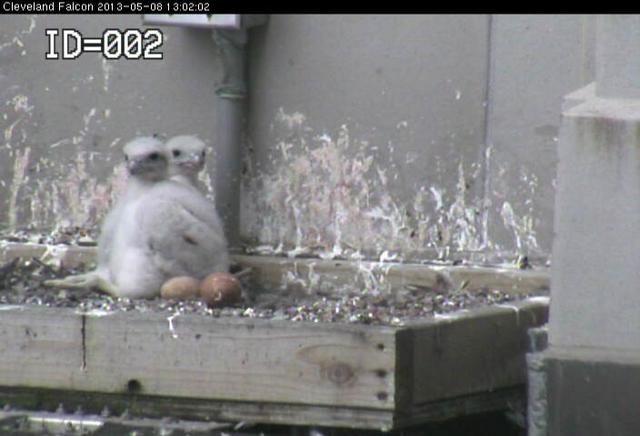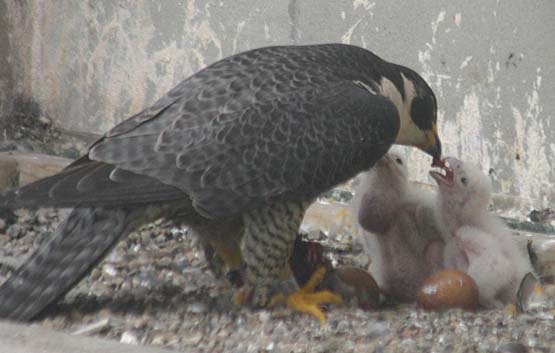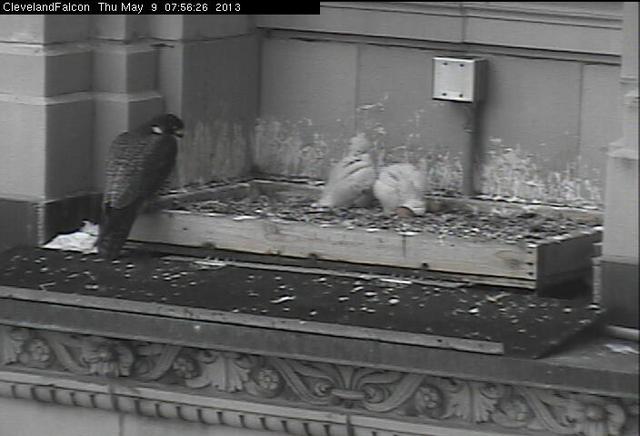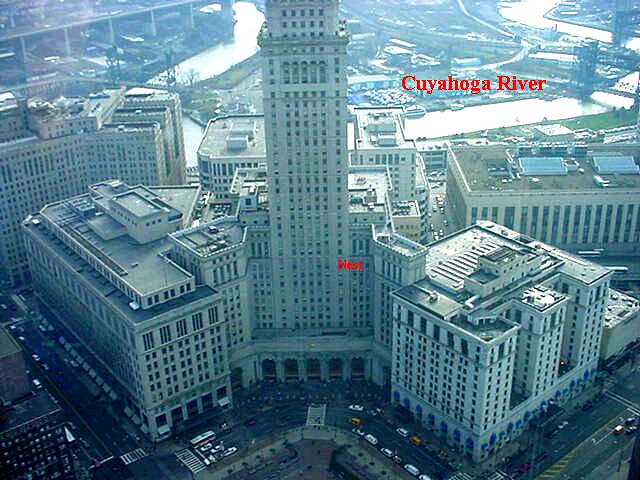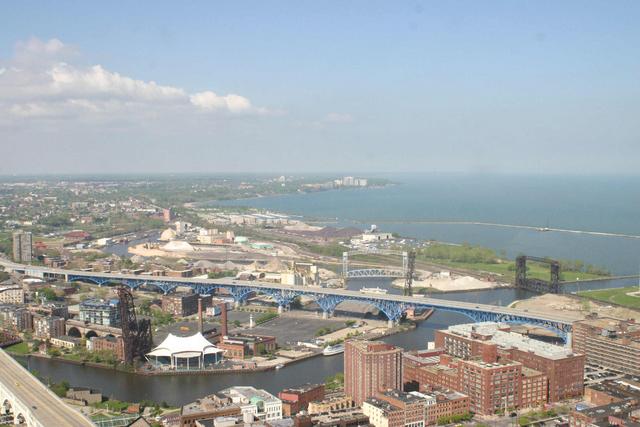FALCON FLASH
Dateline: Cleveland, Ohio
May 9, 2013
Click here to read what happened earlier
Watch the falcons live at: http://www.falconcam-cmnh.org/news.php
Our thanks to the Cleveland Museum of Natural History for sponsoring the FalconCams and for the stills.
The picture of the Terminal Tower is courtesy of falcon fan, Tony Rinicella. Other photos are courtesy of Scott Wright, volunteer peregrine nest monitor. They may be used in any non-commercial publication, electronic or print, but please give photo credit.
The eyasses are growing very fast and will be banded by the Ohio Division of Wildlife on Tuesday May 14th - and they need names. Put on your thinking caps and send in your suggestions for names, but keep in mind that these little fluffy eyasses will soon grow to be fierce predators, the fastest creatures on earth. Also, keep in mind that we will not know their sex until after they are examined on banding day. Send your ideas for names as soon as possible to raptors@hvc.rr.com
You probably know that the eyasses have been fed small bits of meat from their very first meal and that birds are the prey of peregrine falcons. As you monitor the falconcam images, you will see food transfers between Boomer and SW several times a day. Mother birds usually feed the largest and noisiest eyass first, but SW has made sure from the very start that her smallest eyass has plenty to eat as well.
According to Mr. Scott Wright, volunteer nest monitor, “Male falcons will sometimes arrive at the nest with live food, but I have only seen this a few times in my years of monitoring. Most times the impact will stun the food and the talons hold the food until the food becomes food. Most times the male will have killed the prey, clipped the wings, taken off the head, and sent the feathers flying in the wind as he cleans the meal before he feeds his mate and chicks. Many times you cannot even tell what the food was before it was the meal. I have seen the following (not in any order, but by how my mind recalls them) brought into the nestbox: Barn Swallow, Tree Swallow, Red Eyed Vireo, Night Hawk, Black and Yellow-billed Cuckoo, Yellow Warbler, Woodcock, Coot, unknown large Sandpiper, Cedar Waxwing, House Sparrow, Rock Dove, Mourning Dove, unknown Seagull, Red- winged Blackbird, Grackle, Pie-billed Grebe, Robin, unknown Thrush, Song Sparrow, Blue Jay, Flicker, Grey Catbird, Goldfinch..... Many times all you can say is that they brought a LBB to the nest (little Brown Bird) or LGB (little grey bird). What do peregrines eat? Anything that flies that is smaller than them."
Just look at how big the eyasses are now! Have you noticed they are starting to move around the nest?
In Cleveland, the Terminal Tower nestsite now has a 22 year history. The following picture shows the location of SW and Boomer's nestbox on the 12th floor ledge of their skyscraper home (the word “nest” is in red).
Mr. Harvey Webster, Director of Wildlife Resources at the Cleveland Museum of Natural History, built the nestbox that SW and Boomer call home in 1991 and it has been the home of falcon families continuously ever since. It is one of the most successful nestsites in the United States with over 50 chicks hatched and fledged. Mr. Webster and the Cleveland Museum of Natural History have played an important role in helping the species peregrine falcon in its recovery from near extinction in the U.S. Visit the Museum’s website at: http://www.cmnh.org/ For information about the falcons that have nested at this nestsite, visit: http://www.semelfactive.net/CLE/PeregrinesTT.htm
An interesting falcon nesting fact comes from The Canadian Peregrine Foundation: "Historically, Peregrines were renowned for having remarkably stable populations. Records are best documented for Great Britain, where the breeding population remained steady around 800 pairs from the time of Queen Elizabeth I to the Second World War nearly 400 years later. Even more amazingly, some particular nest sites were almost continuously occupied throughout this period."
The following picture gives a birdseye view from SW and Boomer’s skyscraper home. Peregrines like to nest near water. Look on a map and you will see that this nestsite in Cleveland, Ohio is very near the Cuyahoga River that feeds into Lake Erie, one of the Great Lakes.
The eyasses will be banded next week on Tuesday, May14. Send your ideas for names ASAP to raptors@hvc.rr.com
Click here to read what happened next

